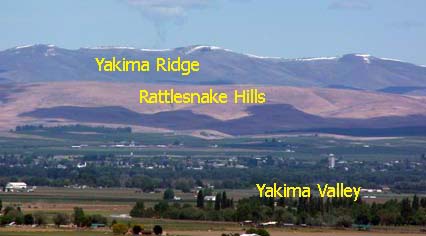|
 The
snowcapped Yakima Ridge to the north (4000 ft. elevation) protects the low-lying
Rattlesnake Hills from Arctic blasts just as the Cascade Range to the west
protects them from rain. The
snowcapped Yakima Ridge to the north (4000 ft. elevation) protects the low-lying
Rattlesnake Hills from Arctic blasts just as the Cascade Range to the west
protects them from rain.
Buena, WSU Public Agricultural Weather Station (PAWS) is within the
Yakima Valley Rattlesnake Hills at 900 feet elevation. It represents the coolest temperatures that could be expected within the region because the station
was originally placed in the coldest area to predict frost for fruit growers. It has a ten-year average accumulated heat units of 2682.61
growing degree-days. This station achieved the desired minimum of 2300 degree-days every year for the past ten years. This station usually reaches 2300 degree-days in September.
Outlook PAWS is also within the boundaries of the
Yakima Valley Rattlesnake Hills at 1300 feet elevation. It
represents the most typical of vineyard temperatures that could be expected because it was located in the middle of Outlook Vineyard to assess the potential of growing wine grapes in the
region. It has an annual average heat unit accumulation of 2869.89 growing degree-days. The station achieved the desired minimum of
2300 degree-days every year for the 6 years of available data. This station reached the critical 2300 degree-days in late August or early
September.
Parker PAWS is
located one mile west of the Rattlesnake Hills. It lies in the low land along the Yakima River at an elevation of 876 ft.
With an annual accumulation of 3133.37 degree-days, it reflects the warmth of the south slope of the Rattlesnake Hills. Parker generally reaches the critical 2300 degree-days in late August.
In contrast,
the south slope of Sagebrush Ridge and the Grandview Flats areas only receive about 2570 degree days, 300 degree-days colder than the Rattlesnake Hills. In 1999, they did not ever
reach the critical 2300 degree days. Grapes ripen about three weeks later in this region.
The ten-year
average for Benton City in the Red Mountain area is 3036, only 167 degree-days warmer than Outlook.
The
Rattlesnake Hills really stands out during extreme winter cold spells. Outlook station is as much as 18o warmer than Walla Walla and 11o warmer than Red
Mountain. In 2004, when Walla Walla was reporting temperatures as low as 21o below zero, Outlook station was a balmy -2.3o. In 2004 the Rattlesnake Hills
expects a normal crop, where Walla Walla is estimated to have a 30% crop.
Where should
you be sourcing your premium wine grapes?
Webmaster
Rattlesnake Wine
© 2024 All rights
reserved
|

